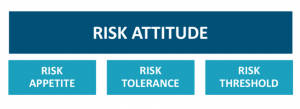Taken together, risk attitude, risk appetite, risk tolerance, and risk threshold
influence the decisions made by individuals and organizations regarding
how much risk to take on and how to manage it.
Risk Tolerance
According to PMBOK Guide 6th Edition,
Risk tolerance is the identified range of acceptable outcomes
Risk tolerance informs you regarding the sensitivity of the organization or to people’s life. High tolerance refers to individuals’ capability to take high-level risk while low tolerance means people are not prepared to accept any sort of risk. It primarily depends on the eagerness of the group of individuals or a corporate to accept or reject risk. A number of factors contribute to risk tolerance that implies a project team is more keen to take the risk if the project is very crucial and vice versa for relatively small or unimportant projects. Other factors may include client satisfaction and the influence of risk on the success of the organization.
Example:
Suppose you are requesting for a project and pitching in an estimate of approximately 500,000 USD. While you are bidding, an organization member informs you that you are not permitted to bid more than the 5% of this amount. Subsequently, 5% will be your tolerance limit.
Risk tolerance is a range and is usually expressed as a percentage below and above the planned value – either project budget or schedule.
Risk Threshold
According to PMBOK 6th Edition:
Risk threshold is the degree of exposure which risks are addressed and below which risks might be acknowledged.
Risk threshold refers to the amount of risk that an individual, a group of people, or an organization is willing to accept. There are specific limits in risk tolerance, while in risk threshold, you are given a clear figure. In a Risk Management Plan, the threshold is pragmatic to the risk exposure which is calculated depending on probability and impact. However, it’s crucial to comprehend when risk exposure gets over the threshold. Consequently, the project management team is responsible to devise plan responses and bring back the risk exposure below the threshold limits.
Threshold. A predetermined value of a measurable project variable that represents a limit that requires action to be taken if it is reached. PMBOK ver 6.
Risk threshold quantifies the risk tolerance with a more accurate figure. Also, it’s the limit beyond which the organization is unable to tolerate the risk. It concerns the amount of risk, and hence the potential consequences or benefits you might gain or lose if the risk event occurs.
Risk Thresholds will determine the acceptable level of overall project risk exposure. PMBOK 6
Example:
You are thinking to bid an agreement. The worth of the contract is estimated to be 200,000 USD. In the middle of the process, you are told that your organization is encountering some financial problems and they are unable to go beyond 5,000 USD, in addition to 200,000 USD. In this situation, your threshold for the project comes out to be 5,000 USD.
You may also find that when we discuss Risk Tolerance, we often talk about the influence of risk in a measurable unit. Though in the case of Risk Threshold, we also take into account the level of certainty. This means that we need to further quantify the risk attitude. For instance, are you willing to accept the risk of 10,000 USD with a 50% probability of occurring?
To figure out the risk threshold, you may need to hold interviews and conduct meetings with stakeholders involved and determine the risk appetite. Afterwards, you will evaluate the risk tolerance and eventually define the risk threshold.
Thresholds are typically expressed as percentage deviations. These are important limits, as they may be used as the reference to implement Avoid Risk strategy. These limits are specified to indicate an agreed-upon amount of variation to be allowed before some action needs to be taken.
Risk Appetite
The degree of uncertainty an organization or individual is willing to accept in anticipation of a reward. PMBOK ver 6.
A high-level general description of acceptance of a level of risk because of no pain no gain. Risk appetite concerns the amount of uncertainty project management team or the stakeholders are willing to take on to gain a benefit. Organizations take risks in order to meet their strategic objectives. Risk Appetite is the amount of risk that an organization is willing to take risks in order to innovate in pursuit of objectives.
Risk appetite is the total exposed amount that an organization wishes to undertake on the basis of risk-return trade-offs for one or more desired and expected outcomes. RIMS
Risk Attitude

Risk attitude is a function of risk appetite, risk tolerance and risk threshold. This holds true for a person or stakeholders and organization both. The risk attitude of an organization or stakeholders is typically calculated in measurable units. Every company has people with different attitudes about risk. This is how the organization or an individual perceives risk.
Risk attitude is the organization’s or individuals’ view/perspective of the perceived qualitative and quantitative value that may be gained in comparison to the related potential loss or losses. RIMS
In summary, understanding and managing risk is essential for individuals and organizations in order to achieve their goals and objectives. Risk attitude, risk appetite, risk tolerance, and risk threshold are all important concepts that help to guide decision-making and risk management strategies. By assessing these factors and taking appropriate action, individuals and organizations can effectively navigate the challenges and opportunities presented by a dynamic and uncertain environment.

